KIA Niro: Air Conditioning System / Repair Procedures
Checking Refrigerant Specifications
- Check refrigerant specifications label inside engine room.
Examples
R-134a 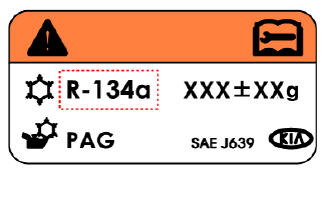
R-1234yf 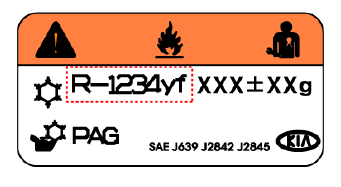
- If refrigerant specifications label is not visible, check the refrigerant service port diameter.
High pressure side
R-134a 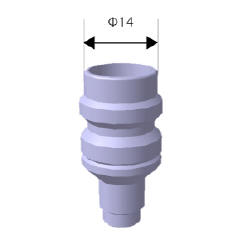
R-1234yf 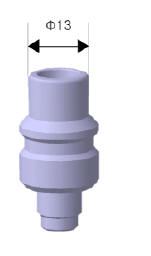
Low pressure side
R-134a 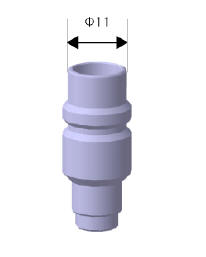
R-1234yf 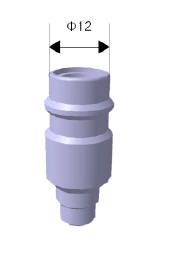
Service port diameter for high/low pressure side varies based on refrigerant specification.
Refrigerant System Service Basics (R- 134a)
- For the electric compressor using high-voltage, use POE oil with high insulation property.
- Use a separate equipment (refrigerant recovery / charger) exclusive for hybrid vehicle maintenance to prevent infusion of PAG oil of non-hybrid vehicles during refrigerant recovery / charging.
Warning
If PAG oil mixes into the POE oil of the system, dielectric breakdown may occur due to decreased volumetric resistivity and the A/C compressor may not work.
Refrigerant Recovery
Use only the UL-listed service equipment certified to meet the requirements of SAE J2210 to remove HFC-134a (R-134a) from the air conditioning system.
Warning
- Air conditioning refrigerant or lubricant vapor can irritate your eyes, nose, or throat.
- Be careful when connecting service equipment.
- Do not breathe in refrigerant or vapor.
If accidental system discharge occurs, ventilate the work area before resume of service.
Additional health and safety information may be obtained from the refrigerant and lubricant manufacturers.
- Connect an R-134a refrigerant Recovery / Recycling / Charging system (A) to the high-pressure service port (C) and the low-pressure service port (B) as shown, following the equipment manufacturer's instructions.

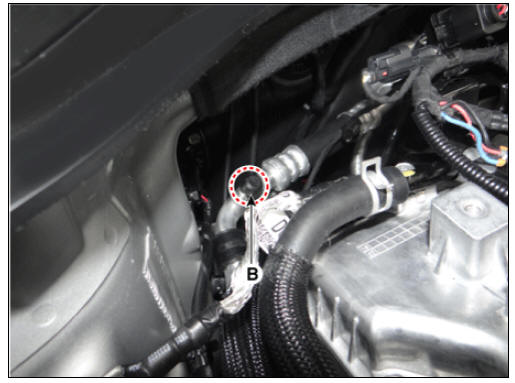
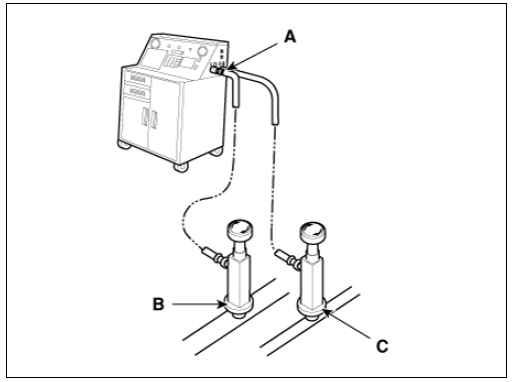
- Measure the amount of refrigerant oil removed from the A/C system after the recovery process is completed. Be sure to install the same amount of new refrigerant oil back into the A/C system before charging.
System Evacuation
Use only the UL-listed service equipment certified to meet the requirements of SAE J2210 to remove HFC-134a (R-134a) from the air conditioning system.
Warning
- Air conditioning refrigerant or lubricant vapor can irritate your eyes, nose, or throat.
- Be careful when connecting service equipment.
- Do not breathe in refrigerant or vapor.
If accidental system discharge occurs, ventilate the work area before resume of service.
Additional health and safety information may be obtained from the refrigerant and lubricant manufacturers.
- When an A/C system has been open to the atmosphere, during installation or service, it must be evacuated using an R-134a refrigerant Recovery / Recycling / Charging system. (If the system has been open for several days, the receiver / drier should be replaced, and the system should be evacuated for several hours.)
- Connect an R-134a refrigerant Recovery / Recycling / Charging system (A) to the high-pressure service port (C) and the low-pressure service port (B) as shown, following the equipment manufacturer's instructions.

- If the low-pressure does not reach more than 93.3 kPa (700 mmHg, 27.6 in.Hg) in 10 minutes, there is probably a leak in the system. Partially charge the system, and check for leaks (see Refrigerant Leak Test.)
- Remove the low pressure valve from the low-pressure service port.
System Charging
Use only the UL-listed service equipment certified to meet the requirements of SAE J2210 to remove HFC-134a (R-134a) from the air conditioning system.
Warning
- Air conditioning refrigerant or lubricant vapor can irritate your eyes, nose, or throat.
- Be careful when connecting service equipment.
- Do not breathe in refrigerant or vapor.
If accidental system discharge occurs, ventilate the work area before resume of service.
Additional health and safety information may be obtained from the refrigerant and lubricant manufacturers.
- Connect an R-134a refrigerant Recovery / Recycling / Charging system (A) to the high-pressure service port (C) as shown, following the equipment manufacturer's instructions.
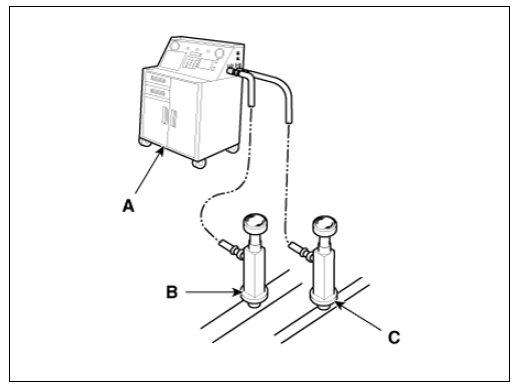
- Add the same amount of new refrigerant oil to the system that was removed during recovery. Use only specified refrigerant oil. Charge the system with R-134a refrigerant. Do not overcharge the system as this will damage the compressor.
Capacity : 550 +- 25g (19.4 +- 0.88 oz.)
Refrigerant Leak Test
Always conduct a leak test with an electronic leak detector whenever leakage or refrigerant is suspected and when conducting service operations accompanied by disassembly or loosening or connection fittings.
Warning
For proper use of the leak detector, follow the manufacturer instructions.
If a gas leak is detected, proceed as follows:
- Check the torque on the connection fittings. If it is too loose, tighten to the proper torque. Check for gas leakage with a leak detector (A).
- If leakage continues even after the fitting has been tightened, discharge the refrigerant from the system, disconnect the fittings, and check their seating faces for damage. Always replace, even if the damage is slight.
- Check the compressor oil and add oil if required.
- Charge the system and recheck for gas leaks. If no leaks are found,
evacuate and charge the system again.
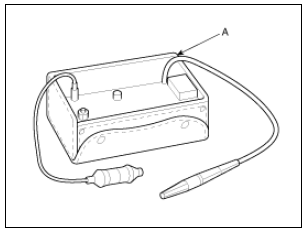
Refrigerant System Service Basics (R- 1234yf)
Refrigerant Identification
- Do not mix HFO-1234yf (R-1234yf) in the vehicle with other refrigerant, such as R-12, R-134a and etc.
- Use only the UL-listed service equipment certified to meet the requirements of SAE standards to recover and recycle R-1234yf from the air conditioning system. Do not use service equipment for the other refrigerant, such as R-12, R-134a and etc.
- Verify what refrigerant is in the system if there is concern that the system has been tampered in any way and check the type and quantity of refrigerant in the A/C system and potential issues arising from accidental or intentional mixing of refrigerants.
- Using an SAE certified refrigerant identification device is recommended to prevent improper recovery and the resulting further spread of contaminated refrigerant, which could potentially damage other A/C systems and service equipment. Contaminated refrigerant (blend of more than one refrigerant or non-system refrigerant) in recovery/recycling equipment could lead to the potential contamination of more refrigerant.
- Certain types of electronic leak detection devices (heated diode or corona discharge) as well as motors, switches, and controls on recovery and recycling machines, could generate sparks that could serve as ignition sources in the presence of refrigerants classified as flammables (A2 or A3) by ASHRAE standard 34 2006.
- It is possible that the mixing of refrigerants in an A/C system can result in higher-than-expected system pressures, system and component damage, diagnostic errors and/or other potential hazards to people and environment.
- In case other refrigerant is mixed, recover the contaminated refrigerant
in the A/C system and dispose it in accordance with all applicable national,
regional or local regulations.
Clean inside the A/C system using the specialized detergent and recharge new refrigerant.
Refrigerant Recovery
Use only the UL-listed service equipment certified to meet the requirements of SAE standards to remove HFO-1234yf (R-1234yf) from the air conditioning system.
Warning
- Air conditioning refrigerant or lubricant vapor can irritate your eyes, nose, or throat.
- Be careful when connecting service equipment.
- Do not breathe in refrigerant or vapor.
If accidental system discharge occurs, ventilate work area before resume of service.
Additional health and safety information may be obtained from the refrigerant and lubricant manufacturers.
- Connect an R-1234yf refrigerant Recovery/Recycling/Charging System (A) to the high-pressure service port (B) and the low-pressure service port (C) as shown, following the equipment manufacturer's instructions.
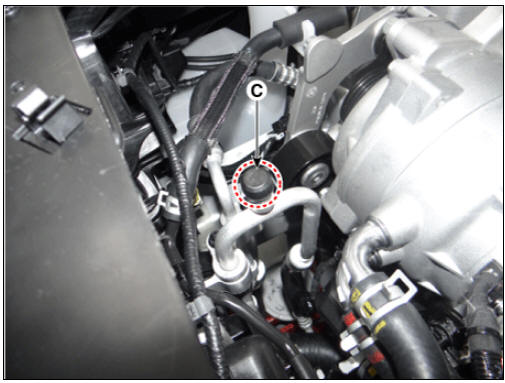
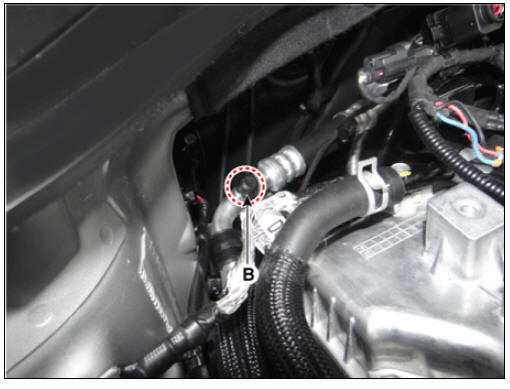
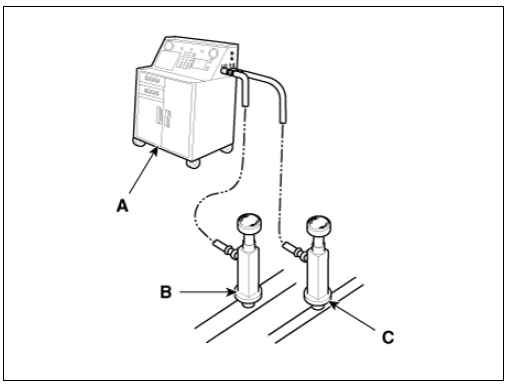
- Measure the amount of refrigerant oil removed from the A/C system after the recovery process is completed. Be sure to install the same amount of new refrigerant oil back into the A/C system before charging.
System Evacuation
Use only the UL-listed service equipment certified to meet the requirements of SAE standards to remove HFO-1234yf (R-1234yf) from the air conditioning system.
Warning
- Air conditioning refrigerant or lubricant vapor can irritate your eyes, nose, or throat.
- Be careful when connecting service equipment.
- Do not breathe in refrigerant or vapor.
If accidental system discharge occurs, ventilate work area before resume of service.
Additional health and safety information may be obtained from the refrigerant and lubricant manufacturers.
- When an A/C System has been open to the atmosphere, during installation or service, it must be evacuated using an R-1234yf refrigerant Recovery/Recycling/Charging System. (If the system has been open for several days, the receiver/dryer should be replaced, and the system should be evacuated for several hours.)
- Connect an R-1234yf refrigerant Recovery/Recycling/Charging System (A) to the high-pressure service port (B) and the low-pressure service port (C) as shown, following the equipment manufacturer's instructions.

- If the low-pressure does not reach more than 87.7 kPa (658 mmHg, 25.9 in.Hg) in 5 minutes, there is probably a leak in the system. Partially charge the system, and check for leaks (see "Refrigerant Leak Test").
- Remove the low pressure valve from the low-pressure service port.
System Charging
Use only the UL-listed service equipment certified to meet the requirements of SAE standards to remove HFO-1234yf (R-1234yf) from the air conditioning system.
Warning
- Air conditioning refrigerant or lubricant vapor can irritate your eyes, nose, or throat.
- Be careful when connecting service equipment.
- Do not breathe in refrigerant or vapor.
If accidental system discharge occurs, ventilate work area before resume of service.
Additional health and safety information may be obtained from the refrigerant and lubricant manufacturers.
- Connect an R-1234yf refrigerant Recovery/Recycling/Charging System (A) to the high-pressure service port (B) and the low-pressure service port (C) as shown, following the equipment manufacturer's instructions.
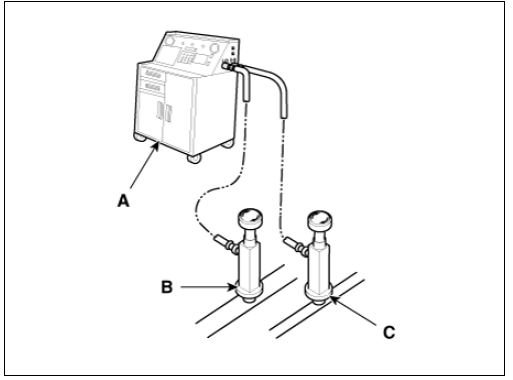
- Add the same amount of new refrigerant oil to the system that was removed during recovery. Use only specified refrigerant oil. Charge the system with R-134a or R-1234yf refrigerant. Do not overcharge the system as it may damage the compressor.
Specified amount 550 +- 25g (19.4 +- 0.8 oz.)
Refrigerant Leak Test
Always conduct a leak test with an electronic leak detector whenever leakage or refrigerant is suspected and when conducting service operations accompanied by disassembly or loosening or connection fittings.
Warning
For proper use of the leak detector, follow the manufacturer instructions.
Warning
Use only leak detection devices certified to SAE standards for use with R-1234yf. Certain leak detection devices (heated diode or corona discharge) could serve as ignition sources in the presence of hydrocarbons or other flammable refrigerants.
If a gas leak is detected, proceed as follows :
- Check the torque on the connection fittings. If it is too loose, tighten to the proper torque. Check for gas leakage with a leak detector (A).
- If leakage continues even after the fitting has been tightened, discharge the refrigerant from the system, disconnect the fittings, and check their seating faces for damage. Always replace, even if the damage is slight.
- Check the compressor oil and add oil if required.
- Charge the system and recheck for gas leaks. If no leaks are found,
evacuate and charge the system again.

READ NEXT:
 Compressor oil Repair procedures | Refrigerant Line
Compressor oil Repair procedures | Refrigerant Line
Air Conditioning System / Components And Components Location
Engine Room
Ambient Temperature Sensor
Receiver-drier
Condenser
Electric A/C Compressor
Discharge hose
The service port (Low pressure)
The service po
 Electric A/C Compressor
Electric A/C Compressor
Electric A/C Compressor body inside inspection
Electric compressor body inside check procedure.
1) Remove the low-pressure pipe from the electric compressor.
2) Check if the copper wire and white thread inside of the compressor was
contamin
SEE MORE:
 Automatic climate control system
Automatic climate control system
Kia NIRO Hybrid
Type A
Type B
Driver's temperature control knob
Passenger's temperature control knob
AUTO (automatic control) button
OFF button
Fan speed control button
Mode selection button
Front windshield defroster bu
 Warning And Caution Labels
Warning And Caution Labels
Engine pressure cap caution
Cooling fan caution
High voltage caution
Inverter reservoir tank cap caution
Battery Caution Label
Warning / Caution Label (Cont'd)
Keep lighted cigarettes and all other flames or sparks away f
Categories
- Home
- KIA Niro EV, Hybrid - Second generation - (SG2) (2021-2024) - Owner's manual
- Kia Niro - First generation - (DE) (2017-2022) - Service and Repair Manual
- Contact Us
